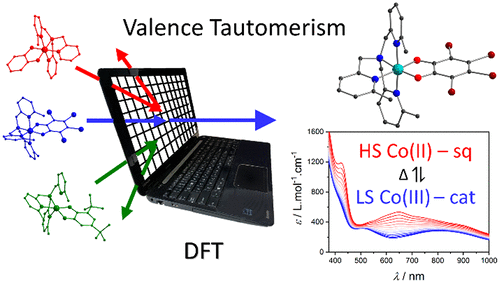当前位置:
X-MOL 学术
›
Inorg. Chem.
›
论文详情
Our official English website, www.x-mol.net, welcomes your
feedback! (Note: you will need to create a separate account there.)
DFT Prediction and Experimental Investigation of Valence Tautomerism in Cobalt-Dioxolene Complexes
Inorganic Chemistry ( IF 4.3 ) Pub Date : 2019-03-20 00:00:00 , DOI: 10.1021/acs.inorgchem.8b03291 Gemma K. Gransbury 1 , Marie-Emmanuelle Boulon 2 , Simon Petrie 3 , Robert W. Gable 1 , Roger J. Mulder 4 , Lorenzo Sorace 2 , Robert Stranger 3 , Colette Boskovic 1
Inorganic Chemistry ( IF 4.3 ) Pub Date : 2019-03-20 00:00:00 , DOI: 10.1021/acs.inorgchem.8b03291 Gemma K. Gransbury 1 , Marie-Emmanuelle Boulon 2 , Simon Petrie 3 , Robert W. Gable 1 , Roger J. Mulder 4 , Lorenzo Sorace 2 , Robert Stranger 3 , Colette Boskovic 1
Affiliation

|
The family of complexes of general formula [Co(Mentpa)(Xdiox)]+ (tpa = tris(2-pyridylmethyl)amine, n = 0–3 corresponds to successive methylation of the 6-position of the pyridine rings; X = Br4, Cl4, H4, 3,5-Me2, 3,5-tBu2; diox = dioxolene) was investigated by density functional theory (DFT) calculations to predict the likelihood of valence tautomerism (VT). The OPBE functional with relativistic and solvent corrections allowed accurate reproduction of trends in spin-state energetics, affording the prediction of VT in complex [Co(Me3tpa)(Br4diox)]+ (1+). One-electron oxidation of neutral precursor [CoII(Me3tpa)(Br4cat)] (1) enabled isolation of target compounds 1(PF6) and 1(BPh4). Solution variable-temperature UV–vis absorption and Evans method magnetic susceptibility data confirm DFT predictions that 1+ exists in a temperature-dependent valence tautomeric equilibrium between low-spin Co(III)-catecholate and high-spin Co(II)-semiquinonate forms. The solution VT transition temperature of 1+ is solvent-tunable with critical temperatures in the range of 291–359 K for the solvents measured. Solid-state magnetic susceptibility measurements of 1(PF6) and 1(BPh4) reveal the onset of VT transitions above room temperature.
中文翻译:

钴-二氧戊烯配合物的价态互变异构现象的DFT预测和实验研究
通式[Co(Me n tpa)(Xdiox)] +(tpa =三(2-吡啶基甲基)胺,n = 0-3的配合物,对应于吡啶环6-位的连续甲基化; X为Br 4,氯4,H 4,3,5--ME 2,3,5-吨卜2 ; DIOX =二氧杂环戊烯)经密度泛函理论(DFT)计算研究来预测价互变异构(VT)的可能性。具有相对论和溶剂校正的OPBE功能可精确再现自旋态高能态的趋势,从而提供了复杂[Co(Me 3 tpa)(Br 4 diox)]中的VT的预测+(1 +)。中性前体[Co II(Me 3 tpa)(Br 4 cat)](1)的单电子氧化能够分离目标化合物1(PF 6)和1(BPh 4)。溶液变温UV-vis吸收和Evans方法的磁化率数据证实了DFT的预测,即低旋Co(III)-儿茶酚酸酯和高旋Co(II)-半奎宁酸酯形式之间的温度相关价互变异构平衡中存在1 +。溶液的VT转变温度为1 +可在临界温度291–359 K范围内对所测量的溶剂进行溶剂调节。固态磁化率测量值1(PF 6)和1(BPh 4)显示了室温以上VT转变的开始。
更新日期:2019-03-20
中文翻译:

钴-二氧戊烯配合物的价态互变异构现象的DFT预测和实验研究
通式[Co(Me n tpa)(Xdiox)] +(tpa =三(2-吡啶基甲基)胺,n = 0-3的配合物,对应于吡啶环6-位的连续甲基化; X为Br 4,氯4,H 4,3,5--ME 2,3,5-吨卜2 ; DIOX =二氧杂环戊烯)经密度泛函理论(DFT)计算研究来预测价互变异构(VT)的可能性。具有相对论和溶剂校正的OPBE功能可精确再现自旋态高能态的趋势,从而提供了复杂[Co(Me 3 tpa)(Br 4 diox)]中的VT的预测+(1 +)。中性前体[Co II(Me 3 tpa)(Br 4 cat)](1)的单电子氧化能够分离目标化合物1(PF 6)和1(BPh 4)。溶液变温UV-vis吸收和Evans方法的磁化率数据证实了DFT的预测,即低旋Co(III)-儿茶酚酸酯和高旋Co(II)-半奎宁酸酯形式之间的温度相关价互变异构平衡中存在1 +。溶液的VT转变温度为1 +可在临界温度291–359 K范围内对所测量的溶剂进行溶剂调节。固态磁化率测量值1(PF 6)和1(BPh 4)显示了室温以上VT转变的开始。

































 京公网安备 11010802027423号
京公网安备 11010802027423号